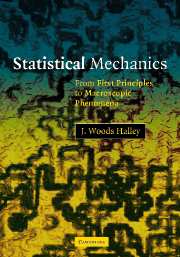Book contents
- Frontmatter
- Contents
- Preface
- Introduction
- Part I Foundations of equilibrium statistical mechanics
- Part II States of matter in equilibrium statistical physics
- 5 Perfect gases
- 6 Imperfect gases
- 7 Statistical mechanics of liquids
- 8 Quantum liquids and solids
- 9 Phase transitions: static properties
- Part III Dynamics
- Appendix: Solutions to selected problems
- Index
7 - Statistical mechanics of liquids
Published online by Cambridge University Press: 05 June 2012
- Frontmatter
- Contents
- Preface
- Introduction
- Part I Foundations of equilibrium statistical mechanics
- Part II States of matter in equilibrium statistical physics
- 5 Perfect gases
- 6 Imperfect gases
- 7 Statistical mechanics of liquids
- 8 Quantum liquids and solids
- 9 Phase transitions: static properties
- Part III Dynamics
- Appendix: Solutions to selected problems
- Index
Summary
Here we briefly review some aspects of the statistical mechanics of liquids. The distinction between a liquid and a gas is not sharp except in the neighborhood of the transition between them which we will discuss in Chapter 10. As a working definition we will consider a system to be a liquid if it lacks the geometrical structure associated, for example, with crystals and for which the density expansions discussed in the last chapter do not converge. This distinction can be made somewhat sharper when we have discussed the relevant correlation functions and phase diagrams. It is to be noted that for atomic and molecular systems which can be treated classically and for which the two body interactions contain a hard core at short distances, there will always be a region of the thermodynamic phase space (for example in the PT diagram) for which the system will behave as a liquid according to this definition.
We begin the discussion by defining correlation functions which are very useful for characterizing the structure of liquids and also for making measurements and formulating theories to describe them. The considerations here apply equally well to the imperfect gases discussed in the last chapter, but they are particularly useful and necessary for the discussion of liquids. We next describe experimental techniques which directly measure some of these correlation functions. Finally we briefly describe two distinct theoretical approaches to the description of liquids: analytical formulations based on approximate summations of series like those described in the last chapter, and numerical simulation.
- Type
- Chapter
- Information
- Statistical MechanicsFrom First Principles to Macroscopic Phenomena, pp. 125 - 144Publisher: Cambridge University PressPrint publication year: 2006



